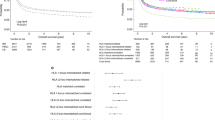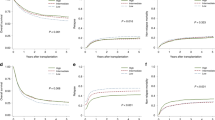Abstract
Multiple studies have documented that racial/ethnic minority patients are less likely to undergo hematopoietic cell transplantation (HCT) in the United States (US), and if they do, they often have worse outcomes. No studies to our knowledge have compared the outcomes of English-speakers to non-English speakers undergoing HCT in the US. To test our hypothesis that non-English speakers have worse outcomes than English speakers after HCT, all transplants performed between 2015 and 2019 at Fred Hutchinson Cancer Research Center in Seattle, WA, USA were analyzed. Cox proportional hazards models were used to test our hypothesis, adjusting for significant clinical covariates. Out of 2051 patients, 106 (5%) were documented to be non-English speakers. Mortality for non-English speakers was not different than English speakers (adjusted HR 1.02, 95% CI 0.63–1.63, p = 0.95). When the analysis was limited to the allogeneic population, the results were similar to the total population (adjusted HR 1.10, 0.64–1.88, p = 0.73). The risk of grade II-IV acute graft-versus-host disease (GVHD) was higher in the non-English speaking subset: adjusted OR 2.01, 95% CI, 1.02–3.98, p = 0.04. These data suggest that non-English speakers have similar survival compared to English speakers following HCT although they have more acute GVHD.
This is a preview of subscription content, access via your institution
Access options
Subscribe to this journal
Receive 12 print issues and online access
$259.00 per year
only $21.58 per issue
Buy this article
- Purchase on Springer Link
- Instant access to full article PDF
Prices may be subject to local taxes which are calculated during checkout



Similar content being viewed by others
Data availability
Contact the corresponding author
References
U.S. Census Bureau. Detailed languages spoken at home and ability to speak English for the population 5 years and over: 2009-2013. https://www.census.gov/data/tables/2013/demo/2009-2013-lang-tables.html (accessed March 6, 2021)
Skube ME, Alexander BH, Beilman, GJ, Tuttle, TM. Impact of patients’ primary language on stage of cancer at diagnosis. Minnesota Med. 2019:14:1883336.
Majhail NS, Omondi NA, Denzen E, Murphy EA, Rizzo JD. Access to hematopoietic cell transplantation in the United States. Biol Blood Marrow Transpl. 2010;16:1070–5.
Jacobs E, Chen AH, Karliner LS, Agger-Gupta N, Mutha S. The need for more research on language barriers in health care: a proposed research agenda. Milbank Q. 2006;84:111–33.
DuBard CA, Gizlice Z. Language spoken and differences in health status, access to care, and receipt of preventive services among US Hispanics. Am J Public Health. 2008;98:2021–8.
Fiscella K, Franks P, Doescher MP, Saver BG. Disparities in health care by race, ethnicity, and language among the insured: findings from a national sample. Med Care. 2002;40:52–59.
Flores G, Abreu M, Tomany-Korman SC. Limited english proficiency, primary language at home, and disparities in children’s health care: how language barriers are measured matters. Public Health Rep. 2005;120:418–30.
Genoff MC, Zaballa A, Gany F, Gonzalez J, Ramirez J, Jewell ST, et al. Navigating Language Barriers: A Systematic Review of Patient Navigators’ Impact on Cancer Screening for Limited English Proficient Patients. J Gen Intern Med. 2016;31:426–34.
Idossa L, Mau LW, Ferguson SS, Denzen E, Murphy E, Moore H. Access to Linguistically Appropriate Information for Blood and Marrow Transplant Patients: Results from Transplant Center Staff Survey. J Cancer Educ. 2019;34:1031–7.
Shah BR, Khan NA, O’Donnell MJ, Kapral MK. Impact of Language Barriers on Stroke Care and Outcomes. Stroke 2015;46:5.
Karliner LS, Kim SE, Meltzer DO, Auerbach AD. Influence of language barriers on outcomes of hospital care for general medicine inpatients. J Hosp Med. 2010;5:276–82.
Linsky A, McIntosh N, Cabral H, Kazis LE. Patient-provider language concordance and colorectal cancer screening. J Gen Intern Med. 2011;26:142–7.
Karliner LS, Ma L, Hofmann M, Kerlikowske K. Language barriers, location of care, and delays in follow-up of abnormal mammograms. Med Care. 2012;50:171–8.
Hari PN, Majhail NS, Zhang MJ, Hassebroek A, Siddiqui F, Ballen K, et al. Race and outcomes of autologous hematopoietic cell transplantation for multiple myeloma. Biol Blood Marrow Transpl. 2010;16:395–402.
Joshua TV, Rizzo JD, Zhang MJ, Hari PN, Kurian S, Pasquini M, et al. Access to hematopoietic stem cell transplantation: effect of race and sex. Cancer 2010;116:3469–76.
Majhail NS, Nayyar S, Santibanez ME, Murphy EA, Denzen EM. Racial disparities in hematopoietic cell transplantation in the United States. Bone Marrow Transpl. 2012;47:1385–90.
Mitchell JM, Meehan KR, Kong J, Schulman KA. Access to bone marrow transplantation for leukemia and lymphoma: the role of sociodemographic factors. J Clin Oncol. 1997;15:2644–51.
Mielcarek M, Gooley T, Martin PJ, Chauncey TR, Young BA, Storb R, et al. Effects of race on survival after stem cell transplantation. Biol Blood Marrow Transpl. 2005;11:231–9.
Baker KS, Davies SM, Majhail NS, Hassebroek A, Klein JP, Ballen K, et al. Race and socioeconomic status influence outcomes of unrelated donor hematopoietic cell transplantation. Biol Blood Marrow Transpl. 2009;15:1543–54.
Serna DS, Lee SJ, Zhang MJ, Baker KS, Eapen M, Horowitz MM, et al. Trends in survival rates after allogeneic hematopoietic stem-cell transplantation for acute and chronic leukemia by ethnicity in the United States and Canada. J Clin Oncol. 2003;21:3754–60.
Le RQ, Bevans M, Savani BN, Mitchell SA, Stringaris K, Koklanaris E, et al. Favorable outcomes in patients surviving 5 or more years after allogeneic hematopoietic stem cell transplantation for hematologic malignancies. Biol Blood Marrow Transpl. 2010;16:1162–70.
Divi C, Koss RG, Schmaltz SP, Loeb JM. Language proficiency and adverse events in US hospitals: a pilot study. Int J Qual Health Care. 2007;19:60–67.
Acknowledgements
This work was supported by grants CA018029 and CA15704.
Author information
Authors and Affiliations
Contributions
Designed study (SJL), performed analysis (TG, CD), interpreted data (all authors), wrote the paper (AM, SJL, TG), critically revised the paper (all authors).
Corresponding author
Ethics declarations
Competing interests
The authors declare no competing interests.
Additional information
Publisher’s note Springer Nature remains neutral with regard to jurisdictional claims in published maps and institutional affiliations.
Rights and permissions
About this article
Cite this article
Mukherjee, A., Gooley, T., Mielcarek, M. et al. Outcomes after hematopoietic cell transplantation among non-English- compared to English-speaking recipients. Bone Marrow Transplant 57, 440–444 (2022). https://doi.org/10.1038/s41409-021-01557-7
Received:
Revised:
Accepted:
Published:
Issue Date:
DOI: https://doi.org/10.1038/s41409-021-01557-7



